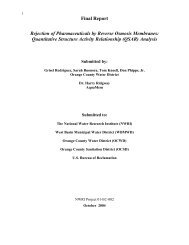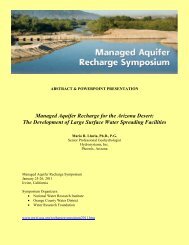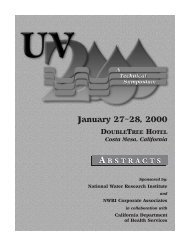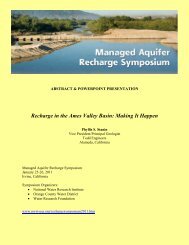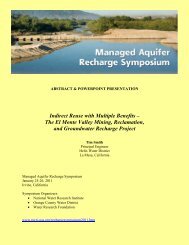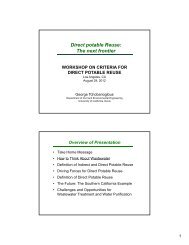RBF_Cover (for eps) - National Water Research Institute
RBF_Cover (for eps) - National Water Research Institute
RBF_Cover (for eps) - National Water Research Institute
You also want an ePaper? Increase the reach of your titles
YUMPU automatically turns print PDFs into web optimized ePapers that Google loves.
20<br />
Laterals<br />
Alternate Systems<br />
In addition to vertical wells and radial collector wells, infiltration galleries can be used to develop<br />
filtered surface-water supplies through <strong>RBF</strong>. These can include trenching parallel or beneath the<br />
river and installing screened gallery pipes that can deliver filtered surface water to sumps and wet<br />
wells. It is also possible to use horizontal directionally drilled wells to induce infiltration from an<br />
adjacent river. These systems are often installed under low head conditions, such that lower per<br />
foot yields are obtained, requiring longer gallery lengths to meet higher capacity needs. It is often<br />
difficult to per<strong>for</strong>m effective well-screen maintenance on these systems.<br />
Well Maintenance<br />
Pump Shaft<br />
Pump<br />
Pump House<br />
Central<br />
Collection<br />
Caisson<br />
Well Screens<br />
(in Laterals)<br />
Figure 3. Typical components of a radial collector well (Ray et al., 2002b).<br />
Land Surface<br />
It is normal <strong>for</strong> well screens to become plugged with chemical (mineral) precipitates and biological<br />
growths (e.g., iron bacteria) over time in alluvial aquifers. The rate of plugging can be exacerbated<br />
if the screen design creates excessive entrance velocities through the slot openings in the well<br />
screens, so it is important that proper screen design considers the water quality and hydraulic<br />
characteristics of the aquifer to maintain entrance and approach velocities within acceptable<br />
ranges to minimize this rate of plugging and extend the intervals between well cleanings. Since<br />
the lineal footage of well screen in a collector well is longer than <strong>for</strong> a vertical well, entrance<br />
velocities are minimized so that the intervals between required maintenance can be extended.<br />
This typically results in lower O&M costs over the life of the collector well.<br />
Well maintenance can be accomplished using a variety of methods including mechanical,<br />
chemical, or a combination of methods. The most effective method to restore well-screen<br />
openings and well efficiency will vary from well field to well field, and is selected based upon<br />
details of the well construction (e.g., screen design), groundwater quality, past results, the nature<br />
of plugging (mineralogic versus biological), and other factors. The use of an ongoing monitoring<br />
and record-keeping program should allow you to track well per<strong>for</strong>mance, identify operating trends,<br />
and predict optimal times <strong>for</strong> per<strong>for</strong>ming maintenance.



